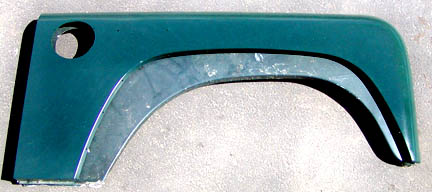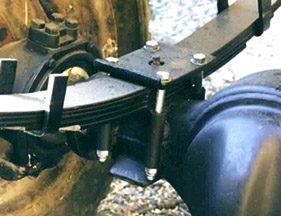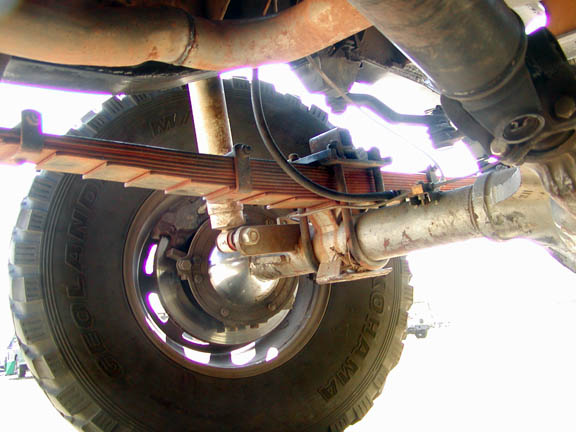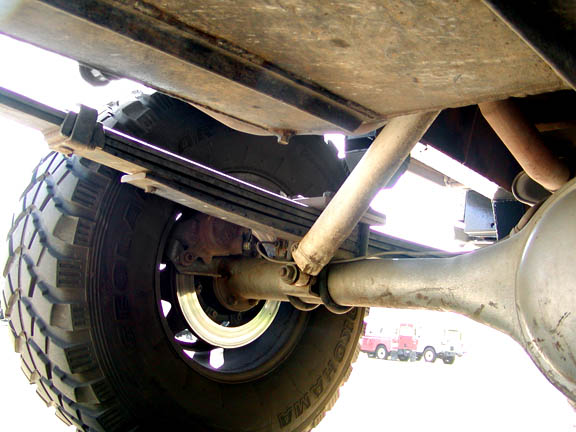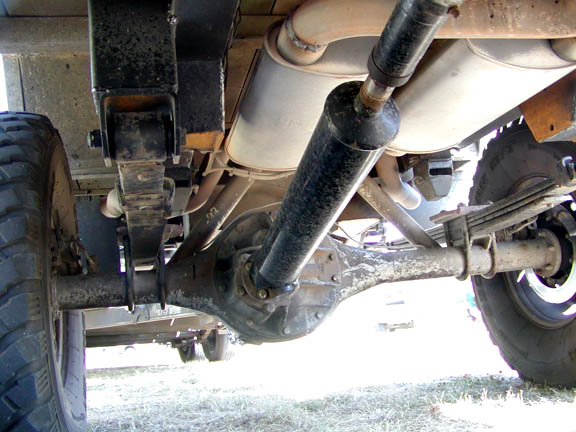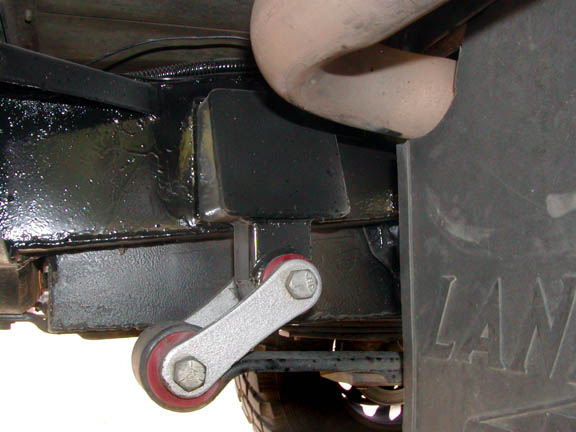
|
What follows are my personal thoughts and current understanding on the subject of adding ground clearance to a series Land Rover. Please do not let them limit your thinking if you are contemplating something substantially different and innovative. Too many Land Rover owners have had their thinking limited by what the factory did or did not do. Technologies have improved and Rover was not necessarily on the leading edge of technology when your Land Rover was built. When you are thinking about making modifications be sure to look at what was done with other marques and what the off road racers have done to keep their cars competitive and the rubber side down. There are some good proven ideas that can enhance the off road capabilities of your Land Rover. Don't pass them by just because the factory never implemented them. No change comes for free. There is a tradeoff for every change you make from stock. The higher you lift your Land Rover the higher you raise its centre of gravity. I read some place that for every inch (2.54 cm) of lift you need to bring the wheelbase outwards 1.5 inches (3.8cm) to retain the same tip over angle. Your Land Rover steering was designed to work properly with the stock king pin angle (line between the top and bottom mount points of swivel ball). When you change this angle from stock the steering looses stability. Changing the angle on the front differential changes the king pin angle. Some taller tyres require wider rims than came stock on series rigs. The widest solid disk wheel available from the factory is a 6-1/2 inch wide 16 inch tall wheel. The largest Land Rover factory wheel that fits on a series Land Rover is the Discovery spoked steel wheel. It is 7 inches wide and 16 inches in diameter. Anytime you change tyre sizes don't forget to adjust your steering stop bolts for minimum turning radius without hitting the inner wheel well. Whenever you go to larger tyres you are increasing the unsprung weight of the car. The more the tyre weighs the greater effect that it has when it goes out of balance. Larger tyres should be rebalanced frequently throughout their lives. Tyres affect the final drive ratio. Taller tyres will give you a higher top speed, higher speed while rock crawling and will require more horse power and fuel to reach a given highway speed. These are just some of the things you need to be aware of when you make modifications to the body height and suspension. It is up to you to decide which factors are most important to you and how you use your car. Above all be safe. Lifting the carThere are basically three kinds of lift. One lifts the entire car. A second lifts the frame but does not change the clearance between the axles and the ground. The third lifts the body in relation to the frame and by itself does not increase ground clearance. Lifting the entire Land Rover: The only way to lift the entire Land Rover and provide additional ground clearance between the ground and the axles is to install taller tyres. For every inch taller tyre that you install under your Land Rover you get a half inch additional ground clearance. The top of a tyre will tilt inwards at extreme upward articulation and outwards at extreme downward articulation. Because of this, the narrower a tyre is, the taller it can be without touching the body during extreme articulation. Since different brand tyres have different actual dimensions the only way you can really tell how a tyre fits is to mount it then take it off roading where the car undergoes extreme articulation. In general 33 to 34 inches depending upon width is about the tallest tyre that a stock series Land Rover can handle under extreme articulation (109 military and 1-ton can go to 36 inch dia). You might be able to use a narrow 35 inch diameter tyre on a stock series Land Rover if you do not encounter extreme articulation. If you want to go with taller or wider tyres there are some additional things that you can do.
Enlarging the space for tyre clearance without lifting the body: There are two primary issues involved here. One is vertical height to fit the tyre and the other is side to side clearance at extreme articulation. The side to side clearance limits at extreme articulation is the most common limiting factor in going to taller tyres for "real" off roading. You need to move the body away from the wheel for articulation clearance with tall tyres.
Downward articulation swings the top of the tyre out towards the wheel well edges. Clearance for taller tyres can be accomplished by enlarging the wheel cut out at the front and rear wheel wells or increasing the static axle to body distance or using narrower tyres. If you decide to cut, Santana military wheel wells and Land Rover light weight wheel well configurations could be used as models for cutting a wheel opening larger. Another thought is getting a set of Defender wheel arch extensions and cutting the wheel openings larger then using the Defender extensions. Upward articulation brings the top of the tyre to the inside of the wheel well. Wide tyres start seeing rear inner wheel well clearance problems at 32 inches diameter. 35 inch wheels will almost always see inner wing clearance problems if any real articulation happens. One method of dealing with this issue is to move your tyres outwards away from the inner wheel well. The Rover wheel bearings and stub axles seem to have lots of reserve strength to handle the additional load of moving the wheels out. You can have your rims offset a little more to the outside. This is generally done by having a shop cut the rims off the wheel discs and rewelding them an inch or more outboard. An alternative is spacer plates that fix to the outside of the drum and has wheel mounting studs on the outside. The other method requires reworking the inner wheel well areas for additional clearance In the rear of the Land Rover that means moving the walls of the side bench inwards and probably upwards as well around near the rear wheels. Rear axles move forwards and rearwards a lot during rough off roading. There is generally enough front to rear clearance for this to occur (keep this movement in mind if reworking inner wheel wells). If front to rear clearance starts to become an issue you can centre the rear wheels in the wheel well to allow greater movement before the tyre contacts the body during articulation. For some reason the series LR rear wheels sit about 2 inches forward of the centre of the rear wheel arches. If the spring hangers are relocated 2 inches to the rear or the axles mounted 2 inches rearwards on the springs additional clearance is gained which can allow for a slightly greater diameter tyre to be used under extreme articulation.
Enlarging the space for tyre clearance by lifting the body above the frame: Lifting the body above the frame is an effective way to achieve additional clearance for taller tyres. Especially if it is used in conjunction with wheel spacers or increased outward offset wheels. This is achieved by removing the body from the frame, adding spacers at the mount points then remounting the body on the spacers. The engineering feat would be reworking the mounts for the bulkhead. This method of lift relies upon larger diameter tyres to provide additional ground clearance The advantage of this is that the relationship of the axles to the rest of the drive train remains unchanged. There are no negative effects on propshaft angles or the steering geometry. In addition it enhances the approach and departure angles. This type of lift does not raise the center of gravity as much since the heavy stuff remains low.
Lifting the frame: Lifting the frame in relation to the axles allows for taller tyres, better approach and departure angles, deeper wading and gets everything except the axles higher for additional ground clearance. Add taller tyres and you have that as well. Negatives include higher centre of gravity, possible changes to the steering geometry, steeper angles on prop shafts and prop shaft to frame clearance issues. The Land Rover frame can be raised in any combination of several ways. Many Land Rovers can be lifted a few inches just by replacing tired leaf springs with new ones. Parabolic leaf springs used in the late 1980s to early 1990s Spanish 4WD Santana fit Land Rovers and can provide an inch or two greater lift than LR leaf springs. Land Rover springs can be rearced to make them taller. The affect on ride and stability will differ by the condition of the springs and how much they are arched. Land Rover extended shackles, used in the 109 one ton and most military spec 109 Land Rovers are 2 inches longer than stock civilian shackles. They are used from the factory in conjunction with extended welded on front spring mounts that are two inches longer than the standard civilian type. Note that the factory did not use extended shackles with 88s. I believe it is because the added lift caused the short rear prop shaft 'U' joints to exceed the maximum recommended angle. If you use the extended shackles in conjunction with standard civilian front spring mounts you will get about one inch in lift. This may be all you need to fit narrow 34 inch tyres. The front steering geometry will be a little off because the front diff will be tilted slightly downwards affecting the kingpin angle. Also the front prop shaft connection will be at a steeper angle. This can be corrected by ether adding a 1/4 inch high wedge between the leaf springs and the axle housing to tilt the doff back up, or by reworking the civilian front springs mounts so they are two inches longer. Reworking the front spring mounts have the added advantage of increasing the lift another inch for a total of approximately 2 inches of lift. A lift of about seven inches can be obtained by mounting the leaf springs over the axle housings. Spacer blocks can be placed between the springs and axle housing for even additional lift. If you want to pursue this kind of radical lift you should consider working with a 4X4 shop that is experienced in doing radical lifts for other street driven 4X4s.
Here is a series of pictures showing the spring
over conversion
Timm's modifications were intended to increase articulation with a minimum of lift. I believe that the front springs are the longer Land Rover rear sparings and the rear springs are off a F150 pickup. The springs have been deached so that they are almost flat.
Several things need to be considered when you lift the body in relation to the axles: 1. You raise the centre of gravity. This means the car will roll at smaller side tilts. If you raise the body more than a couple of inches I strongly suggest that a roll cage be considered. You might also consider having your wheels reworked at a custom wheel shop to bring the offset out. A wider wheelbase is always good in conjunction with a lift. 2. You increase the angle on the short front drive shaft. If the 'U' joint knuckles solidly contact the yolk during articulation the joint tends to break. Radical lifts can be countered by adding wedges between the leaf spring and the axle housing. Unfortunately this has the effect of changing the vertical link steering geometry and making the steering less stable. A way around this is to cut off the mounting flanges at the outside if the front axles, rotate the steering balls and flange back to where the steering vertical link belongs the reweld the flanges into place. The increased drive shaft angularity can quickly become an issue with the short 88 rear prop shaft as well. The 109 shaft is long enough that this seldom becomes an issue. But you can easily exceed maximum recommended rear prop shaft angles when lifting an 88. Don't be surprised if you end up with a prop shaft vibration that will not go away on a lifted 88.. 3. Prop shaft length. A prop shaft has two parts that slide in relation to one another as the suspension moves up and down. One end of the prop shaft has a set of male splines at the end. The yolk end piece has a set of female splines. If the splines were to bottom out when the suspension compresses then the transfer case tends to break. If the splines come apart during extreme downward articulation then the prop shaft rotates free under the car & can provide a short pole vault. Small body lifts can can affect the length between the transfer case and front diff enough to cause the front prop shaft to separate under extreme downward front articulation. Prop shafts can be modified for increased articulation or slight body lifts by going to a longer yolk and spline. Rover used a stock off the shelf Spicer yolk and spline assembly. There are two sizes of Spicer yolk and splines available for the diameter of shaft that Rover uses (I've heard of but not confirmed a third) . Rover used the shorter of the two lengths. You can take your stock prop shaft to a company that works on prop shafts and have the longer yolk and spline installed. This is needed if you have increased articulation and will cover small lifts. If you are lifting the car more than two inches or so the prop shafts may also need to be lengthened. The shop will ask the static length between the prop shaft mounting flanges so you should measure prior to bring yours in for rework. 4. Clearance between the front prop shaft and the cross member that goes under the bell housing will decrease as the lift increases. Also anything that increases downward articulation will decrease this clearance. The cure is to make the same modification that is seen in many 109 military Land Rover frames. They have a diagonal clearance grove in the front of the cross member under the front prop shaft. This can be done in a number of ways. In my Land Rover this was accomplished by cutting out a half circle in the top vertical side of the cross member and hammering the top down to meet the new edge. The new edge was then welded. 5. The rear prop shaft of a 109 goes through a hole in a cross member. If a spring over or taller lift is made in a 109, this hole has to be relocated downwards to maintain clearance during articulation. 6. Shocks will need to be replaced with longer ones. See my page about shocks for additional information Like I said at the beginning, everything is a trade off. Rover made a number of compromises when designing the suspension for your Land Rover. You can not change one thing in the suspension and body height without having it affect other things. One change will often require a number of other changes to bring everything back into acceptable specs. Be careful...be aware..be safe. |
||
|
If you would like to discuss any of the contents, or just say hi, please feel free to .
© 1997, 2001, 2017 TeriAnn Wakeman. All rights reserved. |

